Android切近實(shí)戰(zhàn)(四)-創(chuàng)新互聯(lián)
上一節(jié)我們看了系統(tǒng)參數(shù)的主界面,大家應(yīng)該還有印象,如下

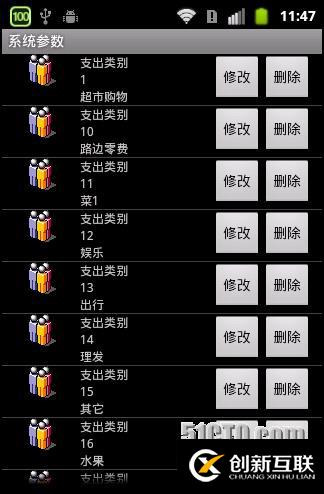
那本節(jié)我們來看一下修改和***。
上節(jié)我已經(jīng)介紹了系統(tǒng)參數(shù)修改以及***的WebService,如下
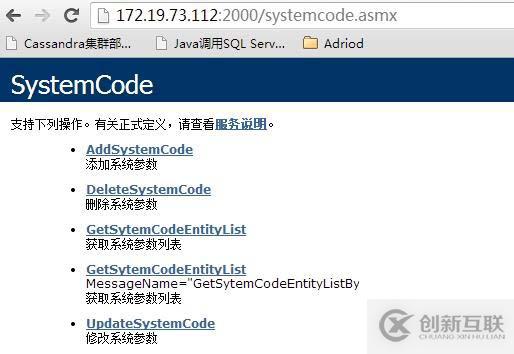
其中系統(tǒng)參數(shù)修改的描述如下
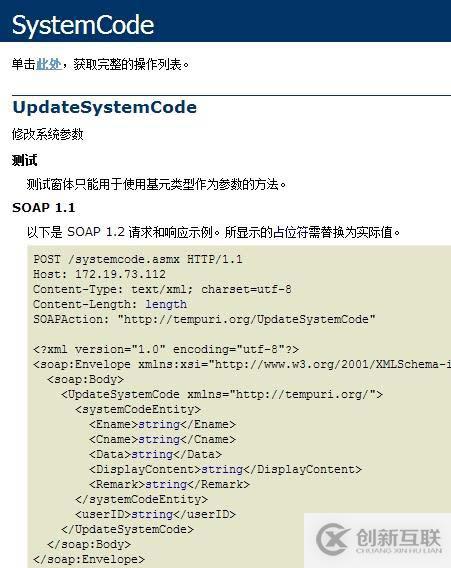
系統(tǒng)參數(shù)***的定義如下
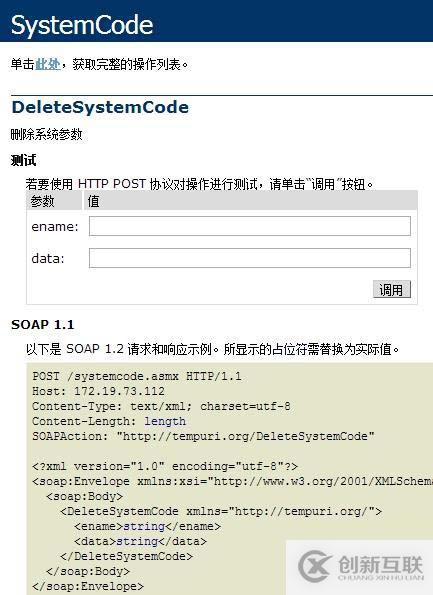
接下來我們需要知道的是如何實(shí)現(xiàn)修改和***按鈕的功能。記得上節(jié)我們使用系統(tǒng)提供的SimpleAdapter去展示listview的數(shù)據(jù)。這樣是無法實(shí)現(xiàn)按鈕的響應(yīng)的。所以在實(shí)現(xiàn)這兩個按鈕的功能之前,首先需要讓他們能夠響應(yīng)點(diǎn)擊事件。所以需要我們自己定義Adapter。
public class customAdapter extends BaseAdapter {
private List<Map<String, Object>> dataList;
private LayoutInflater mInflater;
private Context context;
private String[] keyString;
private int[] valueViewID;
Holder holder;
public customAdapter(Context context,
List<Map<String, Object>> dataList, int resource,
String[] from, int[] to) {
this.dataList = dataList;
this.context = context;
mInflater = (LayoutInflater) this.context
.getSystemService(Context.LAYOUT_INFLATER_SERVICE);
keyString = new String[from.length];
valueViewID = new int[to.length];
System.arraycopy(from, 0, keyString, 0, from.length);
System.arraycopy(to, 0, valueViewID, 0, to.length);
}
@Override
public int getCount() {
return dataList.size();
}
@Override
public Object getItem(int position) {
return dataList.get(position);
}
@Override
public long getItemId(int position) {
return position;
}
public void removeItem(int position) {
dataList.remove(position);
this.notifyDataSetChanged();
}
public View getView(int position, View convertView, ViewGroup parent) {
if (convertView != null) {
holder = (Holder) convertView.getTag();
} else {
convertView = mInflater.inflate(
R.layout.systemcodedetailtemplate, null);
holder = new Holder();
holder.labCname = (TextView) convertView
.findViewById(valueViewID[0]);
holder.labData = (TextView) convertView
.findViewById(valueViewID[1]);
holder.labDisplay = (TextView) convertView
.findViewById(valueViewID[2]);
holder.btnUpdate = (Button) convertView
.findViewById(valueViewID[3]);
holder.btnDelete = (Button) convertView
.findViewById(valueViewID[4]);
convertView.setTag(holder);
}
Map<String, Object> appInfo = dataList.get(position);
if (appInfo != null) {
String cname = appInfo.get(keyString[0]).toString();
String data = appInfo.get(keyString[1]).toString();
String displayContent = appInfo.get(keyString[2]).toString();
holder.labCname.setText(cname);
holder.labData.setText(data);
holder.labDisplay.setText(displayContent);
holder.btnDelete.setOnClickListener(new ViewButtonListener(
position));
holder.btnUpdate.setOnClickListener(new ViewButtonListener(
position));
}
return convertView;
}在構(gòu)造函數(shù)中我們傳入了數(shù)據(jù)源,得到加載xml布局文件的實(shí)例化對象mInflater,以及傳遞進(jìn)來的數(shù)據(jù)源Map<String, Object>中的key值,頁面中的元素的id,用來和key值取到的value作對應(yīng)匹配。
然后再覆蓋BaseAdapter的一些方法。在這里主要看這個getView。
首先判斷是否已經(jīng)加載了根布局模版,如果已加載,則獲取Holder,否則實(shí)例化holder,并將模版內(nèi)的元素賦給Holder。這個Holder怎么理解呢,我覺得是xml布局模版上元素的載體。通過Holder可以拿到該模版上的任何元素。接下來這個appInfo就是當(dāng)前界面上listview所選擇的行的數(shù)據(jù)Map<String, Object>,所以在這里我們可以通過key值拿到value。難道以后將值賦給Holder載體中的各個對應(yīng)元素
String cname = appInfo.get(keyString[0]).toString(); String data = appInfo.get(keyString[1]).toString(); String displayContent = appInfo.get(keyString[2]).toString(); holder.labCname.setText(cname); holder.labData.setText(data); holder.labDisplay.setText(displayContent);
OK,這個其實(shí)就是重寫實(shí)現(xiàn)listView的展示。接下來我們來看這次的重點(diǎn)
holder.btnDelete.setOnClickListener(new ViewButtonListener( position)); holder.btnUpdate.setOnClickListener(new ViewButtonListener( position));
這兩個按鈕是我們第一幅圖中的最右邊的兩個操作按鈕。我們分別為其注冊了單擊事件監(jiān)聽,它的監(jiān)聽實(shí)現(xiàn)類是ViewButtonListener,我們看一下
class ViewButtonListener implements OnClickListener {
private int position;
Object cname;
Object data;
Object displayContent;
EditText txtEname;
EditText txtCname;
EditText txtData;
EditText txtDisplayContent;
EditText txtRemark;
View layout;
ViewButtonListener(int position) {
this.position = position;
cname = dataList.get(position).get("cname");
data = dataList.get(position).get("data");
displayContent = dataList.get(position).get("displaycontent");
LayoutInflater inflater = getLayoutInflater();
layout = inflater.inflate(R.layout.systemcodemodify,
(ViewGroup) findViewById(R.id.modifyDialog));
txtEname = (EditText) layout.findViewById(R.id.txtEname);
txtCname = (EditText) layout.findViewById(R.id.txtCname);
txtData = (EditText) layout.findViewById(R.id.txtData);
txtDisplayContent = (EditText) layout
.findViewById(R.id.txtDisplay);
txtRemark = (EditText) layout.findViewById(R.id.txtRemark);
}
@Override
public void onClick(View view) {
int vid = view.getId();
if (vid == holder.btnUpdate.getId()) {
txtEname.setText(owner.ename);
txtCname.setText(cname.toString());
txtData.setText(data.toString());
txtDisplayContent.setText(displayContent.toString());
txtEname.setEnabled(false);
txtCname.setEnabled(false);
txtData.setEnabled(false);
final AlertDialog.Builder builder = new AlertDialog.Builder(
owner);
builder.setIcon(R.drawable.info);
builder.setTitle(R.string.titleSystemCodeModifyName);
builder.setView(layout);
builder.setPositiveButton(R.string.btnSave, null);
builder.setNegativeButton(R.string.btnClose,null);
final AlertDialog dialog = builder.create();
dialog.show();
dialog.getButton(AlertDialog.BUTTON_POSITIVE)
.setOnClickListener(new View.OnClickListener() {
@Override
public void onClick(View v) {
if (txtDisplayContent.getText().toString()
.trim().length() == 0) {
ShowMessage("顯示值不能為空!");
return;
}
SoapObject soapObject = new systemcodedetail()
.ModifySystemCode(ename, data
.toString(), txtDisplayContent.getText().toString().trim()
.toString(), txtRemark
.getText().toString());
Boolean isSuccess = Boolean
.valueOf(soapObject.getProperty(
"IsSuccess").toString());
if (isSuccess) {
ShowMessage(R.string.SaveSuccess);
dialog.dismiss();
} else {
String errorMsg = soapObject
.getProperty("ErrorMessage")
.toString();
ShowMessage(errorMsg);
}
}
});
} else if (vid == holder.btnDelete.getId()) {
SoapObject soapObject = new systemcodedetail()
.DeleteSystemCode(ename, data.toString());
Boolean isSuccess = Boolean.valueOf(soapObject.getProperty(
"IsSuccess").toString());
if (isSuccess) {
ShowMessage(R.string.DeleteSuccess);
} else {
String errorMsg = soapObject
.getProperty("ErrorMessage").toString();
ShowMessage(errorMsg);
}
}
}
}
class Holder {
public TextView labCname;
public TextView labDisplay;
public TextView labData;
public Button btnUpdate;
public Button btnDelete;
}
}OK,我們看到了,在構(gòu)造函數(shù)中,我們拿到了各個元素,因?yàn)槲覀兊谋4婧?**按鈕的監(jiān)聽那個實(shí)現(xiàn)類都是ViewButtonListener。因此在Onclick事件中,我們需要得知是哪個按鈕觸發(fā)了事件。所以先獲取一下id,如果id是btnUpdate。那么就走修改邏輯,否則走***邏輯。
首先來看一下修改邏輯,創(chuàng)建一個dialog,這個dialog加載的是一個activity,彈出的界面是什么呢,在構(gòu)造函數(shù)中有這樣一段
layout = inflater.inflate(R.layout.systemcodemodify, (ViewGroup) findViewById(R.id.modifyDialog));
在創(chuàng)建dialog的時候我們也看到了這句
builder.setView(layout);
所以彈出的界面就是R.layout.systemcodemodfy。我們來看一下這個界面
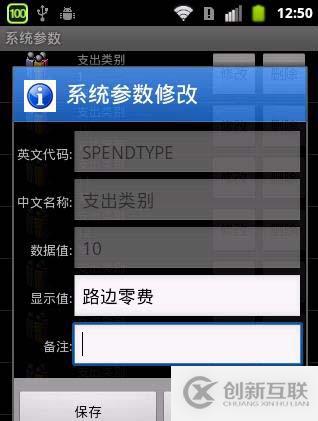
<?xml version="1.0" encoding="utf-8"?> <LinearLayout xmlns:android="http://schemas.android.com/apk/res/android" android:layout_width="match_parent" android:layout_height="match_parent" android:id="@+id/modifyDialog" android:orientation="vertical"> <TableLayout android:id="@+id/tabMain" android:layout_width="fill_parent" android:layout_height="wrap_content" android:padding="3dip" android:stretchColumns="1"> <TableRow> <TextView android:text="@string/labEname" android:textSize="6pt" android:gravity="right" /> <EditText android:id="@+id/txtEname" android:maxLength="25" android:singleLine="true"></EditText> </TableRow> <TableRow> <TextView android:text="@string/labCname" android:textSize="6pt" android:gravity="right" /> <EditText android:id="@+id/txtCname" android:maxLength="50" android:singleLine="true"></EditText> </TableRow> <TableRow> <TextView android:text="@string/labData" android:textSize="6pt" android:gravity="right" /> <EditText android:id="@+id/txtData" android:singleLine="true"></EditText> </TableRow> <TableRow> <TextView android:text="@string/labDisplay" android:textSize="6pt" android:gravity="right" /> <EditText android:id="@+id/txtDisplay" android:singleLine="true"></EditText> </TableRow> <TableRow> <TextView android:text="@string/labRemark" android:textSize="6pt" android:gravity="right" /> <EditText android:id="@+id/txtRemark" android:maxLines="4"></EditText> </TableRow> </TableLayout> <!-- <LinearLayout android:orientation="horizontal"--> <!-- android:gravity="center_horizontal" android:layout_width="fill_parent"--> <!-- android:layout_height="wrap_content">--> <!-- <Button android:id="@+id/btnSave" android:layout_width="110dp"--> <!-- android:layout_height="45dp" android:layout_gravity="center_horizontal"--> <!-- android:text="@string/btnSave" android:textStyle="bold"--> <!-- android:textColor="@color/blue"></Button>--> <!-- <Button android:id="@+id/btnClose" android:layout_width="110dp"--> <!-- android:layout_gravity="center_horizontal" android:layout_height="45dp"--> <!-- android:text="@string/btnClose" android:textStyle="bold"--> <!-- android:textColor="@color/blue"></Button>--> <!-- </LinearLayout>--> </LinearLayout>
OK,就是這個界面,table布局。
再往下看,就是這個setIcon(設(shè)置彈出頁圖標(biāo)),setTitle(彈出頁標(biāo)題),setPostiveButton和setNegativeButton。大家都知道彈出頁在點(diǎn)擊按鈕的時候總是會自動關(guān)閉掉,為了解決這一問題,我們的按鈕點(diǎn)擊事件進(jìn)行了重寫
dialog.getButton(AlertDialog.BUTTON_POSITIVE)
.setOnClickListener(new View.OnClickListener() {
@Override
public void onClick(View v) {}}在點(diǎn)擊事件中,如果說驗(yàn)證沒通過,界面不會關(guān)閉,否則關(guān)閉。我們來看一下效果,界面并沒有關(guān)閉。
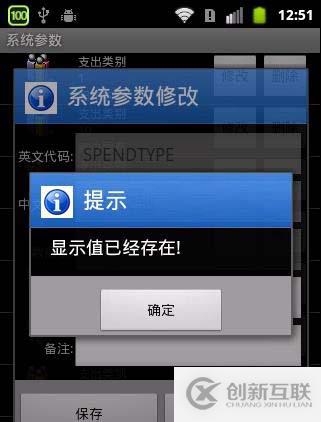
如果保存成功,則關(guān)閉界面

OK,我們接下來看看修改的調(diào)用
private SoapObject ModifySystemCode(String ename, String data,
String display, String remark) {
SoapObject request = new SoapObject(NAMESPACE, METHOD_NAME_PUT);
SystemCodeEntity codeEntity = new SystemCodeEntity();
codeEntity.setProperty(0, ename);
codeEntity.setProperty(2, data);
codeEntity.setProperty(3, display);
codeEntity.setProperty(4, remark);
PropertyInfo pi = new PropertyInfo();
pi.setName("systemCodeEntity");
pi.setValue(codeEntity);
pi.setType(codeEntity.getClass());
request.addProperty(pi);
SoapSerializationEnvelope soapEnvelope = new SoapSerializationEnvelope(
SoapEnvelope.VER11);
soapEnvelope.dotNet = true;
soapEnvelope.setOutputSoapObject(request);
HttpTransportSE httpTS = new HttpTransportSE(URL);
soapEnvelope.bodyOut = httpTS;
soapEnvelope.setOutputSoapObject(request);// 設(shè)置請求參數(shù)
soapEnvelope.addMapping(NAMESPACE, "SystemCodeEntity", codeEntity
.getClass());
try {
httpTS.call(SOAP_ACTION_PUT, soapEnvelope);
} catch (IOException e) {
// TODO Auto-generated catch block
e.printStackTrace();
} catch (XmlPullParserException e) {
// TODO Auto-generated catch block
e.printStackTrace();
}
SoapObject result = null;
try {
result = (SoapObject) soapEnvelope.getResponse();
} catch (SoapFault e) {
// TODO Auto-generated catch block
e.printStackTrace();
}
return result;
}在這里就不多講了。再看一下***的代碼
private SoapObject DeleteSystemCode(String ename, String data) {
SoapObject request = new SoapObject(NAMESPACE, METHOD_NAME_DELETE);
PropertyInfo pi = new PropertyInfo();
pi.setName("ename");
pi.setType(String.class);
pi.setValue(ename);
request.addProperty(pi);
pi = new PropertyInfo();
pi.setName("data");
pi.setType(String.class);
pi.setValue(data);
SoapSerializationEnvelope soapEnvelope = new SoapSerializationEnvelope(
SoapEnvelope.VER11);
soapEnvelope.dotNet = true;
soapEnvelope.setOutputSoapObject(request);
HttpTransportSE httpTS = new HttpTransportSE(URL);
soapEnvelope.bodyOut = httpTS;
soapEnvelope.setOutputSoapObject(request);// 設(shè)置請求參數(shù)
try {
httpTS.call(SOAP_ACTION_DELETE, soapEnvelope);
} catch (IOException e) {
// TODO Auto-generated catch block
e.printStackTrace();
} catch (XmlPullParserException e) {
// TODO Auto-generated catch block
e.printStackTrace();
}
SoapObject result = null;
try {
result = (SoapObject) soapEnvelope.getResponse();
} catch (SoapFault e) {
// TODO Auto-generated catch block
e.printStackTrace();
}
return result;
}OK,本篇到此為止。
另外有需要云服務(wù)器可以了解下創(chuàng)新互聯(lián)scvps.cn,海內(nèi)外云服務(wù)器15元起步,三天無理由+7*72小時售后在線,公司持有idc許可證,提供“云服務(wù)器、裸金屬服務(wù)器、高防服務(wù)器、香港服務(wù)器、美國服務(wù)器、虛擬主機(jī)、免備案服務(wù)器”等云主機(jī)租用服務(wù)以及企業(yè)上云的綜合解決方案,具有“安全穩(wěn)定、簡單易用、服務(wù)可用性高、性價比高”等特點(diǎn)與優(yōu)勢,專為企業(yè)上云打造定制,能夠滿足用戶豐富、多元化的應(yīng)用場景需求。
新聞名稱:Android切近實(shí)戰(zhàn)(四)-創(chuàng)新互聯(lián)
網(wǎng)頁地址:http://vcdvsql.cn/article42/didpec.html
成都網(wǎng)站建設(shè)公司_創(chuàng)新互聯(lián),為您提供微信小程序、服務(wù)器托管、網(wǎng)站內(nèi)鏈、定制開發(fā)、網(wǎng)站設(shè)計、外貿(mào)網(wǎng)站建設(shè)
聲明:本網(wǎng)站發(fā)布的內(nèi)容(圖片、視頻和文字)以用戶投稿、用戶轉(zhuǎn)載內(nèi)容為主,如果涉及侵權(quán)請盡快告知,我們將會在第一時間刪除。文章觀點(diǎn)不代表本網(wǎng)站立場,如需處理請聯(lián)系客服。電話:028-86922220;郵箱:631063699@qq.com。內(nèi)容未經(jīng)允許不得轉(zhuǎn)載,或轉(zhuǎn)載時需注明來源: 創(chuàng)新互聯(lián)
猜你還喜歡下面的內(nèi)容
- Java基于redis實(shí)現(xiàn)分布式鎖的方法-創(chuàng)新互聯(lián)
- 原生js怎么實(shí)現(xiàn)3D輪播圖-創(chuàng)新互聯(lián)
- Python基于geven如何實(shí)現(xiàn)文件字符串查找器的方法-創(chuàng)新互聯(lián)
- 怎么在ubuntu服務(wù)器中安裝python-創(chuàng)新互聯(lián)
- 網(wǎng)紅框架SpringBoot2.x之花式運(yùn)行項(xiàng)目-創(chuàng)新互聯(lián)
- PHP中如何實(shí)現(xiàn)深度優(yōu)先搜索算法-創(chuàng)新互聯(lián)
- tensorflow的Eagerexecution怎么創(chuàng)建-創(chuàng)新互聯(lián)
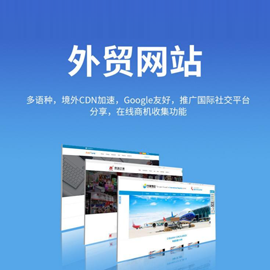
- 品牌網(wǎng)站設(shè)計制作-是企業(yè)對外的名片和形象 2020-11-28
- 品牌網(wǎng)站設(shè)計對企業(yè)來說有什么意義 2021-10-27
- 成都企業(yè)品牌網(wǎng)站設(shè)計的常見布局方式 2023-03-25
- 品牌網(wǎng)站設(shè)計如何達(dá)到展示目的 2013-09-04
- 想要做好品牌網(wǎng)站設(shè)計的4個要點(diǎn) 2022-01-09
- 品牌網(wǎng)站設(shè)計的意義是什么,如何起到這種效果? 2022-09-30
- 怎樣做成都品牌網(wǎng)站設(shè)計才有效果? 2016-12-27
- 網(wǎng)站制作專業(yè)公司更相符公司的成長請求 2022-06-04
- 高端品牌網(wǎng)站設(shè)計注重的五大要素 2022-08-23
- 品牌網(wǎng)站設(shè)計怎樣做更加高端? 2022-11-15
- 品牌網(wǎng)站設(shè)計怎么發(fā)揮效果? 2022-08-10
- 品牌網(wǎng)站設(shè)計的四大原則 2022-12-12